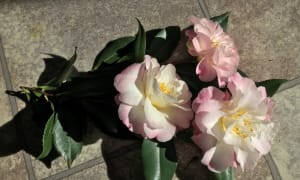
The native Emu Bush with its delicate mauve flower. Photo supplied
AROUND THE GARDEN
Spring is certainly with us as everything is flowering prolifically.
Already finished are my Judas tree with its pretty little pink peas, my two May bushes and a dwarf flowering peach, which was a large ball of white blossom.
Two different lilacs are at their best as is a Wonga vine and a Melaleuca incana which is covered in very tiny cream bottlebrush type flowers.
PRUNING
Immediately after flowering is finished, everything needs cutting back to keep shrubs from becoming straggly or leggy.
Never prune spring flowering trees or shrubs in winter, the exception being roses and fruit trees where we want quality rather than quantity. Prune off frost damage if you have not already done so. Natives can be cut back by about a third, but never into bare wood. The frost was not heavy enough to cut back my rampant Bougainvillea so it needs a good trim to keep it off the roof and it is a mean thorny specimen.
Tecomaria capensis (Cape Honeysuckle) is a hardy, attractive shrub with dark green shiny foliage and bright orange flowers, and it will happily take over the world, so regularly needs removal before it crowds out other shrubs.
It regularly sends out long shoots which creep across the garden until they touch something, put down roots and send up a sturdy trunk against another shrub. It is hard to get rid of. We have been doing battle with it for more than 20 years.
MULCH
We are warned the summer will be hotter and possibly drier so the answer is plenty of mulch. I still like rice straw as it lasts well and stands up to madly scratching blackbirds but it is not as common as it used to be. I bought a 25 litre bag of pea straw but I should have wetted it first as the dust made me itchy.
I’ll try again with it damped. Cow pats, sheep manure or dynamic lifter are good under the mulch.
This brings me to my next heading.
FERTILISER
Roses, passionfruit and citrus have something in common, they are all gross feeders and can all use the same food.
Buy a complete plant food, or Rose or Citrus mix and use according to directions. If you are an organic gardener, use those smelly pellets, which have the advantage of being suitable for use on natives.
Again I emphasise, “read the directions”.
Natives need feeding but do not like phosphorous. There is a “slow release for natives” in the pelleted range but be careful as heat can cause the pellets to open and release their contents.
Slow release pellets are great except in summer.
HOUSE PLANTS
If they are looking poorly, repot with good potting mix into the same size pot if the root system is small; pot one size larger if the roots are crowded.
Orchids and ferns especially benefit from a repot and even from being divided. Tools and pots need to be disinfected. Keep a dip handy. Gardening Australia’s advice on potting mixes is to add about a third perlite to keep the mix lighter and to improve drainage. I think it is exactly what one needs with even expensive potting mix.
A GARDEN APPRECIATION DAY
…is being hosted by Narrandera Garden Club on Sunday, October 25. For a donation of $5 each to Narrandera Can Assist, visitors will receive a voucher for 25 per cent discount at Shady Gum Nursery. Visitors will also receive a map of local gardens which can be appreciated from the street either by car or on foot. There will be a coffee van and also a $5 morning tea, served by Narrandera Soroptimists.
A raffle run by Narrandera Garden Club has as first prize a $250 plant voucher donated by Shady Gum, second prize is a Seasol pack and third a gardener’s pack from Duff’s Mitre 10.
A low cost plant stall will be available at the Nursery carpark on the day. All proceeds to Narrandera Can Assist.





